Large bees (3/4″) and Extra Large bees (1” or longer)
Bumble bees genus Bombus
Texas Parks & Wildlife (TPWD) Species of Greatest Conservation Need
- American Bumblebee (Bombus pensylvanicus)
- Sonoran Bumblebee (Bombus sonorus)
- Variable Cuckoo Bumblebee (Bombus variabilis)
Bumble bee Identification Nine bumble bee species currently known to occur in Texas:
Bombus auricomus, B.bimaculatus, B.fervidus, B.fraternus, B.griseocollis, B.impatiens, B.pensylvanicus, B.variabilis, B.sonorus
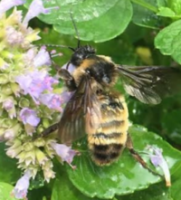
American Bumble Bee
Bombus pensylvanicus
Size: Extra Large 1″ or more
Season: Late emerging, mostly May-Oct
Description: main bumble bee in Houston area. Upper portion of thorax has a yellow band, the remainder is black. On the abdomen, the first 2-4 segments have yellow bands. Males tend to have more yellow bands on the abdomen.
Many commercial beekeepers also use bumble bees to help farmers pollinate crops. Bumble bees are a necessity, because honey bees won’t work gathering pollen when it’s raining or even overcast.
Bumble bees are social and one of the only native bees that live in colonies, nesting in pre-formed cavities in the ground or trees.
Bumble bees are endothermic! They are the only warm-blooded insect, and can regulate their own body temperature and generate heat. However, glyphosate (RoundUp) disrupts their ability to regulate temperature, which affects their ability to keep their brood warm enough to live. Journal Science (2022)
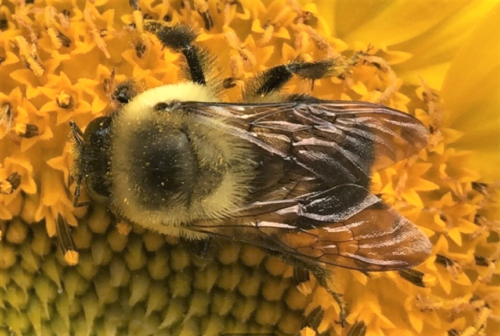
Brown-Belted Bumble bee
Bombus griseocollis
Size: Extra Large 1″ or more
Season: April – Sept.
Description: new bumble bee in Houston area, see here for more information. Named for the distinctive brown stripe around its abdomen, it can quickly be identified by its yellow thorax with a dark spot in the middle. On the abdomen, the first segment is yellow and the second segment is brown, which can vary to yellowish. The Brown-Belted Bumble bee is one of our largest fuzzy bees with queens up to 1 inch long.
Share your photos of bumble bees with Bumble Bee Watch to help track and conserve North America’s bumble bees, and use their BeeSpotter app.
Carpenter Bees genus Xylocopa
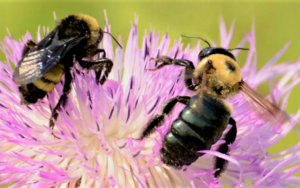
Nesting: Xylocopa is Greek for “wood-worker.” Cavity-dwelling, usually in wood.
How do you tell a bumble bee from a carpenter bee?
The American Bumble Bee (left) has both a hairy thorax and abdomen. The Eastern Carpenter Bee (right) has a hairy thorax, but a shiny abdomen. So, if it’s “shiny on the hiney” it’s a carpenter!
Like bumble bees, carpenter bees (genus Xylocopa) are the largest native bees with hundreds of species worldwide.
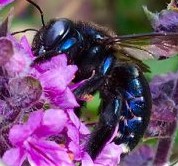
Southern Carpenter Bee Female
Xylocopa micans
Size: 1″ or longer
Season: Mar – Sept
Description: S. Carpenters have a large, black hairless abdomen with a yellow ring of hair on the thorax. Their abdomen is deep purple (in contrast, Eastern Carpenter bees have a black abdomen). Males have disctinctive greenish-yellow eyes.
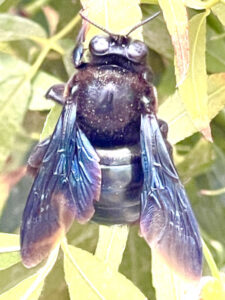
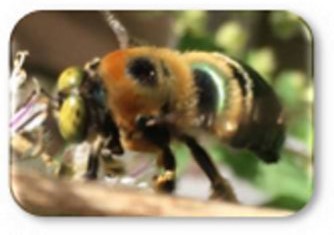
Southern Carpenter Bee Male
Xylocopa micans
Size: 1″ or longer
Season: Mar – Sept
Description: S. Carpenters have a large, black hairless abdomen with a yellow ring of hair on the thorax. Their abdomen is deep purple (in contrast, Eastern Carpenter bees have a black abdomen). Males have disctinctive greenish-yellow eyes.
Species found in Texas include: Southern, Eastern, Texas, Californian, and Horsefly-like carpenter bees.
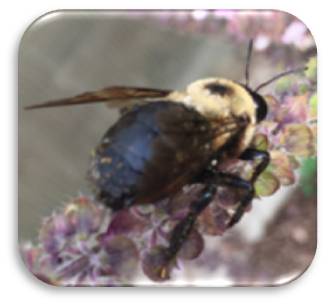
Eastern Carpenter Bee
Xylocopa virginica
Size: 3/4″ or more, “popcorn-size”
Season: Mar – Aug
Description: Large, black shiny abdomen with a yellow ring of hair on the thorax. Males have a yellow/white patch on their face.
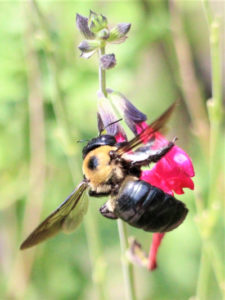
Texas Carpenter Bee
Xylocopa virginica texana
Size: 3/4″ or more, “pecan-size”
Season: Mar – Aug
Description: Subspecies of xylocopa virginica (eastern carpenter bee), their Texas cousin, also found in Oklahoma and Kansas. Similar in appearance, with large, black shiny abdomen, and thorax has yellow hair with black spot. The difference between Xylocopa virginica and Xylocopa virginica texana…texana has black dots on their clypeus, making it look like a little pig nose.
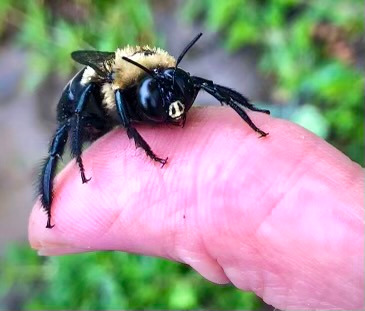
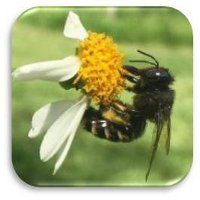
Horsefly-like Carpenter Bee
Xylocopa tabaniformis parkinsoniae
Size: 3/4″ or more, “popcorn-size”
Season: Mar – Aug
Description: This fast-moving carpenter bee has four distinctive “racing stripes” on the lateral portions of the abdomen.
Fun read: Best Little Carpenter Bee Ranch in Texas on Buffalo Bayou, by Texas Master Naturalist Alisa Kline.


